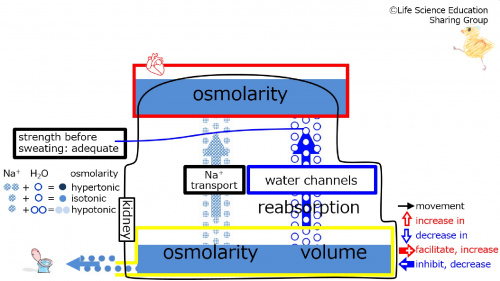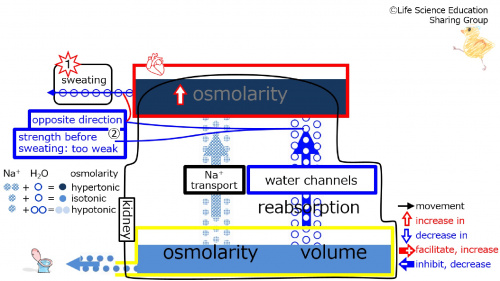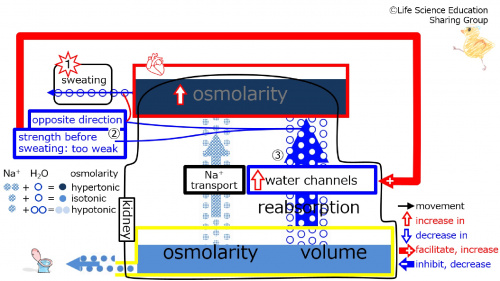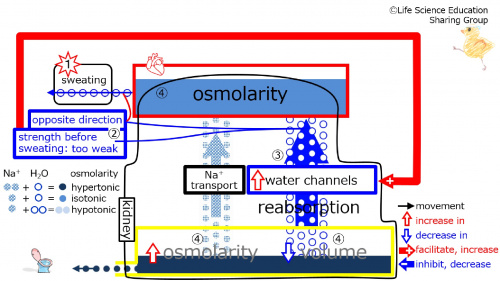「SHolroydAtWeilCornellMedQatar/Urology/Kidney/Tubules/WaterChannels/ControlToSweating」の版間の差分
編集の要約なし |
編集の要約なし |
||
| 1行目: | 1行目: | ||
{{Point|With sweating, the plasma osmolarity increases, and negative feedback increases the number of water channels. | {{Point|With sweating, the plasma osmolarity increases, and negative feedback increases the number of water channels.}} | ||
}} | |||
<!-- | <!-- | ||
| 11行目: | 10行目: | ||
[[メディア:WaterChannelsBaseLine-Eng.mp4|video prior to sweating]]<br> | [[メディア:WaterChannelsBaseLine-Eng.mp4|video prior to sweating]]<br> | ||
--> | --> | ||
Before sweating (at baseline), we will make the assumption that the subject is in homeostasis with adequate strength of the plasma osmolarity-decreasing effect of water reabsorption (through the water channels) as well as normal plasma and urine osmolarities (isotonic) and urine volume. | Before sweating (at baseline), we will make the assumption that the subject is in homeostasis with adequate strength of the plasma osmolarity-decreasing effect of water reabsorption (through the water channels) as well as normal plasma and urine osmolarities (isotonic) and urine volume. | ||
<br style="clear:both;" /> | <br style="clear:both;" /> | ||
</div> | </div> | ||
| 22行目: | 21行目: | ||
Step 1: With sweating, water leaves the plasma and osmolarity increases (concentrated, hypertonic). <br> | Step 1: With sweating, water leaves the plasma and osmolarity increases (concentrated, hypertonic). <br> | ||
<br> | <br> | ||
Step 2: This is in the opposite direction to the plasma osmolarity-decreasing effect of the water reabsorption. Thus, although the strength of the plasma osmolarity-decreasing effect of water reabsorption (through the water channels) was adequate before sweating (at baseline), this strength is now <font color="#00f">too weak (blue)</font> to reverse the increased plasma osmolarity (concentrated, hypertonic) produced by sweating. Control by negative feedback is needed. | Step 2: This is in the opposite direction to the plasma osmolarity-decreasing effect of the water reabsorption. Thus, although the strength of the plasma osmolarity-decreasing effect of water reabsorption (through the water channels) was adequate before sweating (at baseline), this strength is now <font color="#00f">too weak (blue)</font> to reverse the increased plasma osmolarity (concentrated, hypertonic) produced by sweating. Control by negative feedback is needed. | ||
<br style="clear:both;" /> | <br style="clear:both;" /> | ||
</div> | </div> | ||
| 37行目: | 35行目: | ||
[[メディア:WaterChannelsSweating4-Eng.mp4|video just after the increase in vasopressin (ADH) caused by sweating]]<br> | [[メディア:WaterChannelsSweating4-Eng.mp4|video just after the increase in vasopressin (ADH) caused by sweating]]<br> | ||
--> | --> | ||
Step 3: With the strength of the plasma osmolarity-decreasing effect (through the water channels) of the water reabsorption before sweating (at baseline) being <font color="#00f">too weak (blue)</font>, the negative feedback <font color="#ff0000">increases (red)</font> the water reabsorption from the tubule.This increases the water reabsorption from the tubule. | Step 3: With the strength of the plasma osmolarity-decreasing effect (through the water channels) of the water reabsorption before sweating (at baseline) being <font color="#00f">too weak (blue)</font>, the negative feedback <font color="#ff0000">increases (red)</font> the water reabsorption from the tubule.This increases the water reabsorption from the tubule. | ||
<br style="clear:both;" /> | <br style="clear:both;" /> | ||
| 45行目: | 43行目: | ||
[[メディア:WaterChannelsSweating5-Eng.mp4|video showing the changes in plasma and urine after the increase in vasopressin (ADH) caused by sweating]]<br> | [[メディア:WaterChannelsSweating5-Eng.mp4|video showing the changes in plasma and urine after the increase in vasopressin (ADH) caused by sweating]]<br> | ||
--> | --> | ||
Step 4: With the increase in water reabsorption, diluted (hypotonic) solution enters the plasma. This will lead to a reverse in the increased plasma osmolarity (concentrated, hypertonic) produced by sweating, decreasing it towards normal (baseline, isotonic) osmolarity. Because diluted (hypotonic) solution leaves the tubule due to reabsorption, the fluid remaining in the tubule has increased osmolarity (concentrated, hypertonic). Also, with the increase in water reabsorption, there is less water remaining in the tubule. Overall, the urine becomes concentrated and decreases in volume. | Step 4: With the increase in water reabsorption, diluted (hypotonic) solution enters the plasma. This will lead to a reverse in the increased plasma osmolarity (concentrated, hypertonic) produced by sweating, decreasing it towards normal (baseline, isotonic) osmolarity. Because diluted (hypotonic) solution leaves the tubule due to reabsorption, the fluid remaining in the tubule has increased osmolarity (concentrated, hypertonic). Also, with the increase in water reabsorption, there is less water remaining in the tubule. Overall, the urine becomes concentrated and decreases in volume. | ||
<br style="clear:both;" /> | <br style="clear:both;" /> | ||
</div> | </div> | ||
| 54行目: | 51行目: | ||
//LEVEL:2 | //LEVEL:2 | ||
//RAND | //RAND | ||
With sweating, the plasma osmolarity increases, and negative feedback {~=increases~decreases} the number of water channels. | With sweating, the plasma osmolarity increases, and negative feedback {~=increases~decreases} the number of water channels. | ||
//LEVEL:3 | //LEVEL:3 | ||
//RAND | //RAND | ||
With sweating, the plasma osmolarity {~=increases~decreases}. This is in the {~same direction as~=opposite direction to} the plasma {~osmolarity-increasing~=osmolarity-decreasing} effect of the water reabsorption from the tubule (through the water channels). The negative feedback {~=increases~decreases} the water channels. This will {~increase~=decrease} plasma osmolarity (returning to isotonic). | With sweating, the plasma osmolarity {~=increases~decreases}. This is in the {~same direction as~=opposite direction to} the plasma {~osmolarity-increasing~=osmolarity-decreasing} effect of the water reabsorption from the tubule (through the water channels). The negative feedback {~=increases~decreases} the water channels. This will {~increase~=decrease} plasma osmolarity (returning to isotonic). | ||
//LEVEL:4 | //LEVEL:4 | ||
2020年3月31日 (火) 10:25時点における版
| With sweating, the plasma osmolarity increases, and negative feedback increases the number of water channels. |
Before sweating (at baseline), we will make the assumption that the subject is in homeostasis with adequate strength of the plasma osmolarity-decreasing effect of water reabsorption (through the water channels) as well as normal plasma and urine osmolarities (isotonic) and urine volume.
Step 1: With sweating, water leaves the plasma and osmolarity increases (concentrated, hypertonic).
Step 2: This is in the opposite direction to the plasma osmolarity-decreasing effect of the water reabsorption. Thus, although the strength of the plasma osmolarity-decreasing effect of water reabsorption (through the water channels) was adequate before sweating (at baseline), this strength is now too weak (blue) to reverse the increased plasma osmolarity (concentrated, hypertonic) produced by sweating. Control by negative feedback is needed.
Step 3: With the strength of the plasma osmolarity-decreasing effect (through the water channels) of the water reabsorption before sweating (at baseline) being too weak (blue), the negative feedback increases (red) the water reabsorption from the tubule.This increases the water reabsorption from the tubule.
Step 4: With the increase in water reabsorption, diluted (hypotonic) solution enters the plasma. This will lead to a reverse in the increased plasma osmolarity (concentrated, hypertonic) produced by sweating, decreasing it towards normal (baseline, isotonic) osmolarity. Because diluted (hypotonic) solution leaves the tubule due to reabsorption, the fluid remaining in the tubule has increased osmolarity (concentrated, hypertonic). Also, with the increase in water reabsorption, there is less water remaining in the tubule. Overall, the urine becomes concentrated and decreases in volume.
Challenge Quiz
With sweating, the plasma osmolarity increases, and negative feedback increases decreases the number of water channels.
With sweating, the plasma osmolarity increases decreases . This is in the same direction as opposite direction to the plasma osmolarity-increasing osmolarity-decreasing effect of the water reabsorption from the tubule (through the water channels). The negative feedback increases decreases the water channels. This will increase decrease plasma osmolarity (returning to isotonic).
With sweating, water enters leaves the plasma and osmolarity increases decreases .This is in the same direction as opposite direction to the plasma osmolarity-decreasing effect of the water reabsorption (through the water channels). Thus, although the strength of the plasma osmolarity-decreasing effect of water reabsorption (through the water channels) was too weak adequate too strong before sweating (at baseline), this strength is now too strong adequate too weak to reverse the increased decreased plasma osmolarity produced by sweating. The negative feedback increases decreases the number of water channels. With the increase decrease in water reabsorption from the tubule, concentrated diluted solution enters the plasma. This will lead to a reverse in increased decreased plasma osmolarity from sweating, increasing decreasing it towards separate from normal (baseline) osmolarity. Because concentrated diluted solution leaves the tubule due to reabsorption, the fluid remaining in the tubule has an increased a decreased osmolarity. Also, with the increase decrease in water reabsorption, there is more less water remaining in the tubule. Overall, the urine becomes concentrated diluted and increases decreases in volume.




